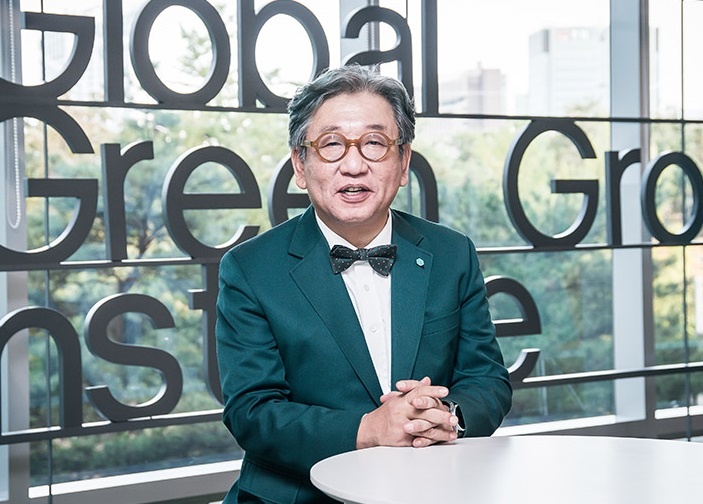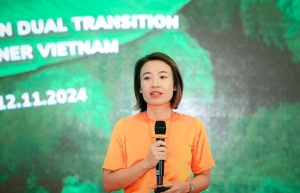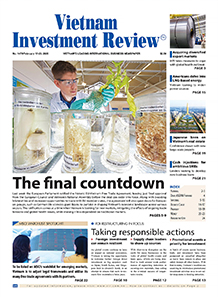Support for green innovation with AI
Global dynamics are becoming increasingly complex – with shifting geopolitical landscapes, shrinking development budgets, and uncertainties about the future climate policy commitments. In this context, how do you see the future of the global climate movement?
 |
| Sang-Hyup Kim, director-general of the Global Green Growth Institute (GGGI) |
Climate change represents the defining challenge of our time, requiring unified global action, despite some governments’ reluctance to acknowledge it. As impacts become increasingly visible worldwide, citizens continue demanding protection and action against climate disasters.
Conversely, renewable energy has achieved a record-breaking surge in 2024, constituting over 92 per cent of new global electricity capacity - exceeding Brazil and Japan’s combined capacity - while powering economic growth, creating jobs, reducing costs, and offering compelling investment opportunities as prices continue to plummet.
COP30 President-Designate Ambassador André Corrêa do Lago recently called for partnerships among diverse stakeholders beyond the UN Framework Convention on Climate Change – in finance, subnational governments, private sector, civil society, academia, and technology – to leverage high-impact solutions.
At COP29 last year, developed nations committed to mobilising at least $300 billion annually for developing countries’ climate action by 2035, with an aspirational goal of $1.3 trillion – a target requiring a significant step up in private investment.
Hence, in these uncertain times, “coalitions of the willing” become crucial when nations face economic, political, or geopolitical paralysis. Organisations like ours are uniquely positioned to convene transformative public-private-philanthropic partnerships that can deliver the ambitious climate finance needed at unprecedented speed and scale to avert catastrophe.
What actions should the international community prioritise to stay on track?
Scientists confirm that limiting warming to 1.5°C remains possible but requires urgent action and leadership on two critical fronts. First, countries must submit ambitious new national climate plans by September that align with the 1.5-degree limit, cover all emissions, and contribute to reducing global emissions by 60 per cent by 2035 compared to 2019.
These plans must provide investors with certainty while supporting a just green transition and the G20, as the largest emitters, must lead this effort.
Second, climate finance for developing countries must increase significantly. The COP29 finance agreement must be fully implemented, with a credible roadmap to mobilise $1.3 trillion annually by 2035. Developed nations must honour their commitment to double adaptation finance to at least $40 billion yearly, while ensuring the Loss and Damage fund becomes operational.
Success requires stronger collaboration across governments, society, and economic sectors. Despite challenges, the rewards of climate leadership are substantial. Green growth is the prize, and this turning point presents an opportunity we must seize.
In what ways can AI drive green growth and climate actions, particularly in developing countries like Vietnam, and which sectors stand to benefit the most?
The transformative power of AI lies in its ability to optimise processes, predict outcomes, and foster informed decision-making. AI has an immense potential to drive climate action. Applications of AI for climate action are multiple, across the time continuum of climate change: from improved climate modelling to mitigation in key emitting sectors, to climate disaster prevention and adaptation.
For example, in the energy sector, AI can optimise smart grids, improve renewable energy integration and enhance energy efficiency. A study from the Boston Consulting Group estimates that proven AI-enabled use cases could reduce global emissions by 5-10 per cent by 2030.
Another key area where AI can support the green transition is through the development of AI-powered measurement, reporting, and verification systems. These systems will help improve the accuracy and efficiency of emissions tracking and reporting, enabling governments to make better-informed decisions when developing their climate policies.
AI’s environmental footprint, particularly data centre energy consumption, is a growing concern. How can we balance AI’s benefits with its resource-intensive nature?
AI is driving a new industrial revolution with far-reaching implications for decades to come. When deployed responsibly, AI can significantly accelerate green, inclusive growth, making it a new strategic priority for the GGGI.
At the AI Action Summit in Paris, I emphasised the importance of multilateralism and sustainability in AI. AI should function as a global public good benefiting all countries, particularly in advancing sustainable development goals. The environmental impact of AI, especially energy and water consumption by data centres, has also rightfully gained international attention.
In Paris, the GGGI joined the Coalition for Sustainable AI with dual objectives: deploying AI to accelerate green growth and enabling sustainable, accessible AI across member states and partners. And we are also exploring support for greening digital infrastructure, including data centres.
Several Asian countries have implemented green data centre policies and standards. Singapore’s Green Data Centre Roadmap, for instance, supports sustainable digital economy growth. Access to green, reliable power supply is key for digital investments. With regards to Vietnam, the emerging data centre industry faces challenges from high power sector emissions but also presents opportunities for renewable energy expansion.
Tech giants like Google, AWS, Samsung Electronics, and Microsoft are pioneering renewable energy purchasing agreements, with Google becoming the world’s largest corporate consumer of clean energy. This new demand for clean, reliable power sources can become a driving force to green the power sector.
How do you foresee the potential of the carbon market, and what is the GGGI’s approach in supporting development?
Carbon markets are evolving as crucial tools in the global fight against climate change. Domestically, cap-and-trade schemes allow emissions-reducing facilities to profit by selling allowances to higher-emitting counterparts, while requiring careful implementation to balance climate goals with economic competitiveness.
South Korea established Asia’s first mandatory Emission Trading Scheme in 2015, while Vietnam is making significant progress towards implementing a similar scheme, with a pilot starting in June.
The GGGI has been supporting the Vietnamese government by helping to introduce actors and stakeholders of the Korean ETS to Vietnamese government officials to share lessons learned in establishing such schemes.
In parallel to domestic schemes, international carbon trading, governed by Article 6 of the Paris Agreement, enables cross-border emissions reduction transfers. Negotiations on the rules for the mechanism were completed at COP29.
Article 6 carbon markets have tremendous potential to facilitate efficient climate finance flows between countries and accelerate progress towards net-zero. They build on lessons from the Kyoto Protocol’s Clean Development Mechanism (CDM) and establish robust environmental integrity standards that may become the benchmark for both compliance and voluntary markets.
A global leader in technical support for Article 6, the GGGI has been working for over five years with governments, supporting their preparations for participating in markets, and shaping new ways to scale these up. The Carbon Transaction Facility, launched by the GGGI weeks before the COP29 decision, is a new vehicle to scale up carbon trading support and markets, from 20 countries to 30 by year-end.
Our work focuses on supporting potential selling countries, shaping policy and regulations, strengthening institutions through establishing processes and procedures for participation in Article 6, and developing a pipeline of mitigation activities that could generate trades.
The potential for Article 6 carbon markets is huge. Markets are the best way to incorporate the private sector as solution providers and, thanks to lessons from the CDM, Article 6 markets start from a much more robust position.
We believe Article 6 will be adopted by many mandating bodies or buying countries and even the private sector as the minimum standard for environmental integrity. This will further streamline activities, add to liquidity and therefore scale.
How has the GGGI been supporting Vietnam’s green transition so far, and what are your priorities moving forward?
Over the past decade, the GGGI has been a key partner to Vietnam in advancing green growth and supporting its net-zero goal by developing catalytic climate projects, mobilising investments, and driving implementation.
By 2024, we had provided policy support to 15 government agencies and technical assistance to over 20 corporate developers including startups, helping mobilise more than $300 million in climate finance.
In 2024, we supported the first green bond issuances of Vietcombank, the country’s largest state-owned bank, and Techcombank, the largest private commercial bank, in partnership with the Ministry of Finance and the Luxembourg government. Similar support was extended to the corporate thematic bond issuers, such as AquaOne (a water treatment company serving public needs) and IDI–Sao Mai Group (focused on the sustainable seafood sector).
We also launched the Accelerating Innovative Startups for Energy Efficiency with the Ministry of Industry and Trade and the European Union – the country’s first government-led energy efficiency startup accelerator. Building on this model, the GGGI is preparing to launch a new climate tech accelerator in 2025 with the Ministry of Finance and the Korea International Cooperation Agency, focusing on agriculture and the circular economy.
These accelerators promote startups that apply AI and digital solutions to drive green transitions in these key sectors. In parallel, the GGGI is actively originating projects that apply AI to measurement, reporting, and verification for carbon markets across multiple sectors.
Last December, the GGGI and the Vietnamese government also adopted the Country Planning Framework 2024–2028, aiming to mobilise $1 billion across seven priority areas. Building on this momentum, we will continue to support the country’s innovation through AI and the digital economy, clean hydrogen, and carbon transactions as part of its green growth initiatives.
 | Leading businesses key to spurring dual transformation The role of pioneering businesses, alongside government policies, is essential for driving systematic and effective dual transformation. |
 | Wide-ranging support can ensure green-digital wins Digital transformation and the green transition are no longer a choice, but implementation is still a headache for both businesses and the government. Bui Thu Thuy, deputy director general of the Agency for Enterprise Development under the Ministry of Planning and Investment, told VIR’s Nguyen Huong about government support for businesses, and the benefits for them. |
 | Green consumption trends on the rise in Vietnam Green consumption is rapidly gaining momentum in Vietnam thanks to increased awareness of environmental protection and sustainability, impacting consumer purchasing habits and presenting both opportunities and challenges for businesses, particularly small- and medium-sized enterprises (SMEs). |
 | Dual transformation can empower innovative startups A workshop on how startups can harness resources for green and digital transformation took place on November 26 at TECHFEST 2024 in Haiphong. |
What the stars mean:
★ Poor ★ ★ Promising ★★★ Good ★★★★ Very good ★★★★★ Exceptional
Related Contents
Latest News
More News
- Schaeffler reports strong early output from Dong Nai solar project (December 12, 2025 | 15:16)
- Forestry conference highlights biodiversity and sustainability goals (December 09, 2025 | 13:35)
- Home Credit honoured among top 10 sustainable companies in trade and services (December 09, 2025 | 12:18)
- SCG and seven member companies honoured in Top 100 Sustainable Businesses 2025 (December 08, 2025 | 09:00)
- Nestlé Vietnam pioneers sustainable development and promotes business connections (December 06, 2025 | 12:09)
- CSI 2025 highlights rise of Vietnam’s green champions (December 06, 2025 | 09:00)
- Acecook Vietnam named among top 100 sustainable businesses (December 06, 2025 | 08:00)
- Vietnam’s forest carbon credits draw global interest (December 05, 2025 | 17:41)
- Coro Energy to launch BESS Pilot in Vietnam (December 04, 2025 | 15:12)
- Vietnam strengthens energy storage pathway (December 04, 2025 | 15:05)

 Tag:
Tag:






















 Mobile Version
Mobile Version